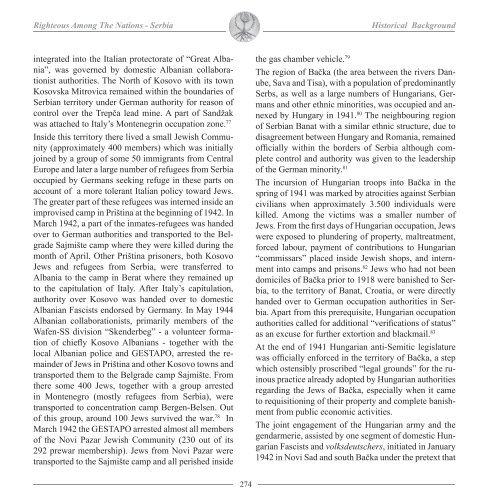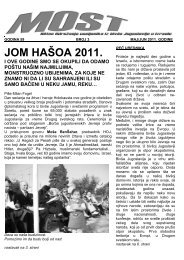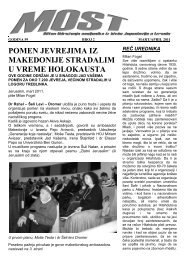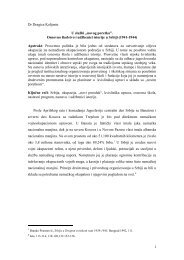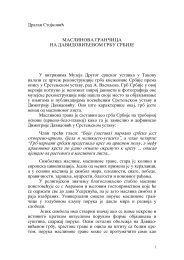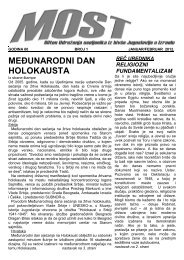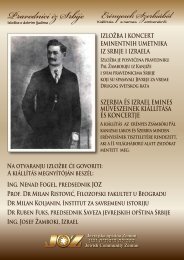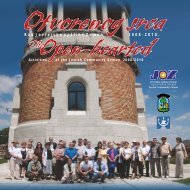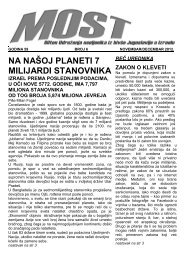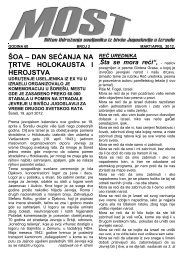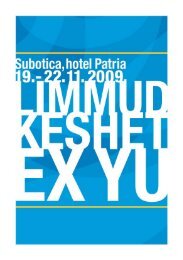Book on the Righteous - Jevrejska opština Zemun
Book on the Righteous - Jevrejska opština Zemun
Book on the Righteous - Jevrejska opština Zemun
You also want an ePaper? Increase the reach of your titles
YUMPU automatically turns print PDFs into web optimized ePapers that Google loves.
<strong>Righteous</strong> Am<strong>on</strong>g The Nati<strong>on</strong>s - Serbia<br />
Historical Background<br />
integrated into <strong>the</strong> Italian protectorate of “Great Albania”,<br />
was governed by domestic Albanian collaborati<strong>on</strong>ist<br />
authorities. The North of Kosovo with its town<br />
Kosovska Mitrovica remained within <strong>the</strong> boundaries of<br />
Serbian territory under German authority for reas<strong>on</strong> of<br />
c<strong>on</strong>trol over <strong>the</strong> Trepča lead mine. A part of Sandžak<br />
was attached to Italy’s M<strong>on</strong>tenegrin occupati<strong>on</strong> z<strong>on</strong>e. 77<br />
Inside this territory <strong>the</strong>re lived a small Jewish Community<br />
(approximately 400 members) which was initially<br />
joined by a group of some 50 immigrants from Central<br />
Europe and later a large number of refugees from Serbia<br />
occupied by Germans seeking refuge in <strong>the</strong>se parts <strong>on</strong><br />
account of a more tolerant Italian policy toward Jews.<br />
The greater part of <strong>the</strong>se refugees was interned inside an<br />
improvised camp in Priština at <strong>the</strong> beginning of 1942. In<br />
March 1942, a part of <strong>the</strong> inmates-refugees was handed<br />
over to German authorities and transported to <strong>the</strong> Belgrade<br />
Sajmište camp where <strong>the</strong>y were killed during <strong>the</strong><br />
m<strong>on</strong>th of April. O<strong>the</strong>r Priština pris<strong>on</strong>ers, both Kosovo<br />
Jews and refugees from Serbia, were transferred to<br />
Albania to <strong>the</strong> camp in Berat where <strong>the</strong>y remained up<br />
to <strong>the</strong> capitulati<strong>on</strong> of Italy. After Italy’s capitulati<strong>on</strong>,<br />
authority over Kosovo was handed over to domestic<br />
Albanian Fascists endorsed by Germany. In May 1944<br />
Albanian collaborati<strong>on</strong>ists, primarily members of <strong>the</strong><br />
Wafen-SS divisi<strong>on</strong> “Skenderbeg” - a volunteer formati<strong>on</strong><br />
of chiefly Kosovo Albanians - toge<strong>the</strong>r with <strong>the</strong><br />
local Albanian police and GESTAPO, arrested <strong>the</strong> remainder<br />
of Jews in Priština and o<strong>the</strong>r Kosovo towns and<br />
transported <strong>the</strong>m to <strong>the</strong> Belgrade camp Sajmište. From<br />
<strong>the</strong>re some 400 Jews, toge<strong>the</strong>r with a group arrested<br />
in M<strong>on</strong>tenegro (mostly refugees from Serbia), were<br />
transported to c<strong>on</strong>centrati<strong>on</strong> camp Bergen-Belsen. Out<br />
of this group, around 100 Jews survived <strong>the</strong> war. 78 In<br />
March 1942 <strong>the</strong> GESTAPO arrested almost all members<br />
of <strong>the</strong> Novi Pazar Jewish Community (230 out of its<br />
292 prewar membership). Jews from Novi Pazar were<br />
transported to <strong>the</strong> Sajmište camp and all perished inside<br />
<strong>the</strong> gas chamber vehicle. 79<br />
The regi<strong>on</strong> of Bačka (<strong>the</strong> area between <strong>the</strong> rivers Danube,<br />
Sava and Tisa), with a populati<strong>on</strong> of predominantly<br />
Serbs, as well as a large numbers of Hungarians, Germans<br />
and o<strong>the</strong>r ethnic minorities, was occupied and annexed<br />
by Hungary in 1941. 80 The neighbouring regi<strong>on</strong><br />
of Serbian Banat with a similar ethnic structure, due to<br />
disagreement between Hungary and Romania, remained<br />
officially within <strong>the</strong> borders of Serbia although complete<br />
c<strong>on</strong>trol and authority was given to <strong>the</strong> leadership<br />
of <strong>the</strong> German minority. 81<br />
The incursi<strong>on</strong> of Hungarian troops into Bačka in <strong>the</strong><br />
spring of 1941 was marked by atrocities against Serbian<br />
civilians when approximately 3.500 individuals were<br />
killed. Am<strong>on</strong>g <strong>the</strong> victims was a smaller number of<br />
Jews. From <strong>the</strong> first days of Hungarian occupati<strong>on</strong>, Jews<br />
were exposed to plundering of property, maltreatment,<br />
forced labour, payment of c<strong>on</strong>tributi<strong>on</strong>s to Hungarian<br />
“commissars” placed inside Jewish shops, and internment<br />
into camps and pris<strong>on</strong>s. 82 Jews who had not been<br />
domiciles of Bačka prior to 1918 were banished to Serbia,<br />
to <strong>the</strong> territory of Banat, Croatia, or were directly<br />
handed over to German occupati<strong>on</strong> authorities in Serbia.<br />
Apart from this prerequisite, Hungarian occupati<strong>on</strong><br />
authorities called for additi<strong>on</strong>al “verificati<strong>on</strong>s of status”<br />
as an excuse for fur<strong>the</strong>r extorti<strong>on</strong> and blackmail. 83<br />
At <strong>the</strong> end of 1941 Hungarian anti-Semitic legislature<br />
was officially enforced in <strong>the</strong> territory of Bačka, a step<br />
which ostensibly proscribed “legal grounds” for <strong>the</strong> ruinous<br />
practice already adopted by Hungarian authorities<br />
regarding <strong>the</strong> Jews of Bačka, especially when it came<br />
to requisiti<strong>on</strong>ing of <strong>the</strong>ir property and complete banishment<br />
from public ec<strong>on</strong>omic activities.<br />
The joint engagement of <strong>the</strong> Hungarian army and <strong>the</strong><br />
gendarmerie, assisted by <strong>on</strong>e segment of domestic Hungarian<br />
Fascists and volksdeutschers, initiated in January<br />
1942 in Novi Sad and south Bačka under <strong>the</strong> pretext that<br />
274


